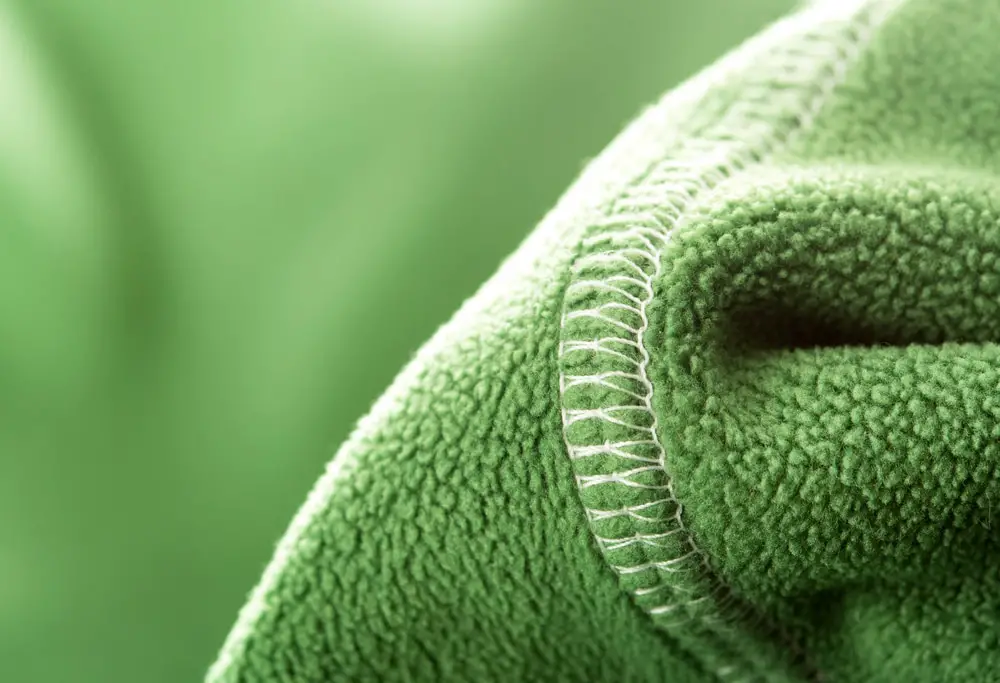Every piece of fabric that we use today is made from some material. The most significant differentiation is a natural or synthetic fiber which is then divided into several others.
For most people, the material doesn’t play as big of a role as it should do. Every material has different properties meaning that it won’t be suitable for everyone. Even different ratios of the same blend of materials can differ a lot. As a result, there are tons of options with tons of properties, and choosing the right one for your specific needs can be a struggle.
It’s no secret that I’m not a huge fan of cotton, especially when it comes to socks. It provides plenty of disadvantages that are remedied with other materials that I use.
Among the many alternatives to cotton is fleece, which brings me to today’s topic. I will outline what fleece is, how it compares with cotton and if it’s better.
Table of Contents
What is Fleece?

To most people’s surprise, fleece is a synthetic material that got its name from a sheep’s coat. Despite the origin of the word, fleece is still synthetic which is made mainly from polyester. There are several reasons why I say mostly.
The first one is that it’s not entirely from polyester, and you will find fleece with some natural fibers like wool or rayon. With this blend, the fleece fabric gets vibrant and increases the volume. In some cases, you may even find fleece with a small amount of cotton fibers.
The second reason I said “moslty” is that polyester is getting replaced in recent years. Some manufacturers have moved to recycling and use recycled materials like plastic. This is a cheaper and more eco-friendly option.
As a result, fleece is a lightweight material that can keep you warm while maintaining breathability, especially when it comes to socks.
Differences Between Fleece and Cotton
Making a comparison between cotton and fleece is not as simple as most people think. Considering that there are multiple fleece blends, I won’t be covering all of them. Instead, I will focus on fleece made from polyester, as that is the most common one you’ll find.
The main difference, of course, is the material, which results in most of the other differences. Cotton is a natural fiber that comes from the plant with the same name. On the other hand, polyester is a synthetic material derived from a process that includes plastic, chemicals, and petroleum products.
As I said, the choice of materials can determine the properties. Take the texture, for example. Cotton is known for being smooth and soft and rarely leads to skin irritation. Fleece, being a synthetic material, is not as soft, and while there the chances of skin irritation are slim, I believe that cotton is softer on the skin.
This leads me to comfort, and the winner is cotton. If you ever touched cotton, you will know how comfortable it is on the skin. Fleece, on the other hand, isn’t as much. You won’t see anyone comparing it to sandpaper or something like that, but you won’t be comparing it with cotton either.
Some people have problems with sweaty feet; in which case, fleece is superior. Cotton as a material can absorb quite a lot of moisture, leading to quite long drying times. In specific scenarios, this can be unacceptable. Fleece is far less absorbent when it comes to wicking, which leads to significantly shorter drying times.
This next comparison doesn’t really go in favor of fleece. Specific scenarios require the material to breathe, and in the case of socks, that can be crucial. Unfortunately, in this duel, cotton is more breathable than fleece. I wouldn’t categorize fleece as the worst in terms of breathability, but cotton is a bit better.
Another aspect where cotton leads over fleece is in terms of odor. Cotton is a material that can keep your feet odor-free. Don’t expect to wear a pair of socks for weeks with no odor. Several days will be fine, which is more than what fleece can handle. Since it’s synthetic, it can retain odor from your feet, and you may begin to notice it after a day of use.
Last but not least, its longevity, something that fleece is quite good at. Don’t get me wrong, cotton is quite long-lasting, but fleece is a bit better.
Is Fleece Warmer than Cotton?
Yes, it is, but things are not as straightforward as you think. If you’re looking for warmth in the winter, cotton can get the job done, but you’ll need extra layers to achieve that. Fleece, on the other hand, can keep your feet warmer with fewer layers.
When you compare layer for layer, fleece is a clear winner and will keep your feet warmer
What is the Best Fleece Material?
Okay, so right off the bat, I’ll have to disappoint you and say that the answer to this question will depend on you and your needs. Since there are several types of fleeces, one is not the best at everything. To help you get your answer, I will briefly explain each fleece type, and you will have a better idea of which one will work better for you.
Cotton
I know I said that fleece is a synthetic material, but there is a cotton-based version as well. You may find them in sweatshirts or sweatpants with a smooth surface on the outside, and a plush-like feel on the inside.
Polyester
In recent years, polyester becomes quite popular and is the most common one you’ll find on the shelves. Many may confuse both due to the smooth outside and plush inside, but there are a few slight differences. The exterior is slightly shiny, and thanks to the polyester, it doesn’t absorb as much moisture.
Lycra spandex
Despite the name, this type of fleece isn’t Lycra-based. The Lycra spandex fleece is cotton-based with a small amount of Lycra. In terms of properties, it’s mostly the same as with the cotton fleece, but thanks to the Lycra spandex combination, it stretches more.
Microfleece
When it comes to fleece designed for performance-oriented use cases, microfleece is the best one there is. The double-sided design means that the microfleece is thin and light. As a result, the moisture-wicking properties are exceptional.
Polar
For colder situations, polar fleece is the way to go, as the name suggests. This is essentially microfleece but thicker. As a result, it is much warmer and popular for blankets and lower temperatures.
French terry
Unlike some of the other fleeces, the French terry has an unbrushed surface on the inside and out. It means that you won’t get the plush surface making it thinner and less soft on the skin
Slub
This kind of fleece is knitted from two yarns. Both of them have a different thickness and makes the slub fleece textured.
Sherpa
Last but not least is the Sherpa, a fleece that is made entirely from polyester. The resulting material is fluffily designed to look like wool. This type of fleece is quite common in cases where additional warmth is needed.
Is Fleece Good for Hiking?
Yes, it is, but the right type of fleece is essential. Hiking is a strenuous activity in which comfort and breathability are crucial. Wearing socks that don’t help which moisture too good will lead to wet feet. On the other hand, hiking in winter conditions means that on top of everything else, you will need to keep your feet warmer.
Fleece is an excellent choice of material for hiking, especially when compared with cotton. I’ve talked about hiking with cotton socks in greater length, and it’s not something that I’d recommend.
The relatively short dry time and excellent breathability make the fleece a superb choice of material for hikers.

